De Gids. Jaargang 174
(2011)– [tijdschrift] Gids, De–
[pagina 281]
| |
[pagina 282]
| |
 | |
[pagina 283]
| |
CarThis slide is dated March 1969, which was before I met Rudy. Gabriel, aged three, is in the back. The other cars in the picture are right-hand drive, so it must have been taken in London, where Rudy often stayed with friends, one of whom owned a Delage. I never saw this Delage, but I heard a lot about it, as I did about Rudy's own cars. At one time he had eight, in various stages of disrepair, which lived on the street in front of his house in Boulogne. Their names became familiar: Zèbre, Talbot, Delahaye, Bentley, Traction. There was one that had such a large petrol tank that the first time it was filled up the garageman thought it leaked; it was made for the days when petrol stations were hundreds of kilometres apart. A couple of others ended up with friends near Paris; I saw them there as if in a museum. One of Rudy's Tractions was with friends of friends near Leiden; Rudy was asked to drive it to a birthday party a few years ago. When we met he had a Mehari, later a ds, then a gs, then a cx. After that our cars became ever less interesting; you cannot tinker with a modern car as you could with these vintage ones, and certainly not without a garage. Looking at old photographs one's fingers itch to turn time backwards. In this case they itch literally; whenever there was an old car in a video or dvd Rudy would make me wind the film back to get a proper look at it. He even bought a video recorder that allowed one to watch frame by frame. When he could see the front of a car he could always identify it (except for the Americans, which he looked down upon). But all too often the cameraman was oblivious of connoisseurs and the car would shoot past and off the screen, its vital bonnet and radiator just not visible, no matter how often we rewound it. But here, although this photo demonstrates the problem brilliantly, he could have told me straightaway what sort of car it was. | |
[pagina 284]
| |
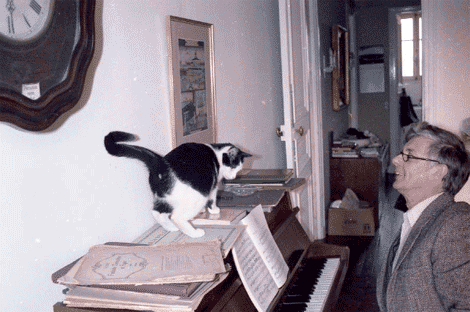 © Sarah Hart
| |
[pagina 285]
| |
PianoThis piano stood in Rudy's study, which was also the dining room, in our flat in the rue des Ecoles in Paris. It was a very ugly piano, made in Eastern Europe, but it had an excellent sound. We rented it from the piano shop across the road, Pianos Anders, who offered to sell it to us when we left the rue des Ecoles for 8,000 francs. We didn't do it and regretted it ever after. The music on top of the piano is Fantaisie Chromatique et Fugue by Bach and Pièces mélodiques pour quatre mains by Diabelli, and the music Rudy was playing from is either ‘Komm lieber Mai’, a song by Mozart which I was trying to sing, or part of Die schöne Müllerin by Schubert, which he was trying to sing. The cat is Vincent, born in 1976 in Puteaux and given to me by a friend who found him through an advertisement in Libération; he lived to be 20 and lies buried in the garden in Leiden. He and Rudy had a chasing game, only played when they were alone in the house, called ‘Help, help, the cat!’ The piece of paper stuck in the clock says ‘Pecunia non olet’, one of the many snippets of text that Rudy cut out of newspapers and attached to paintings, door and clocks. He did it with headlines too and he had a famous collection about K.L. Poll, most of which started with the words ‘Poll says...’ He used to change texts in newspapers too, adding letters and adapting others, and I shall never forget how we sat there in the office of Pianos Anders while the man strained to see what Rudy had written before the name of the shop on our rental contract: ‘Maak Uw Pianos Anders.’ | |
[pagina 286]
| |
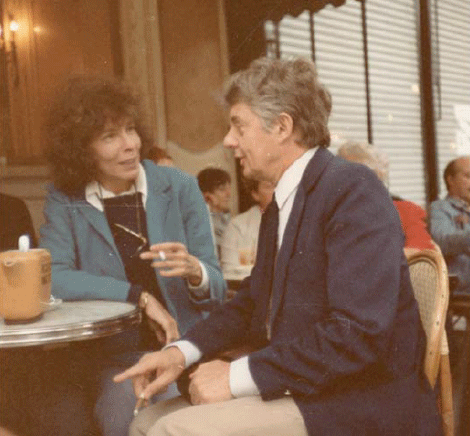 | |
[pagina 287]
| |
Renate RubinsteinThe terrace of the Deux Magots, 3rd July 1982. That is the date on the back, in Renate's writing, but the clothes do not look very summery. It must have been a cold July. The pose is very characteristic, they would have been talking nonstop, about everything from Norbert Elias to Michael Frayn, from cats to China. Renate talked a lot, she could overwhelm the timid, but Rudy had lived long enough in France not to miss his chance in conversation, and he was certainly not timid. They used to talk for hours on the phone as well; Rudy still knew Renate's number by heart long after her death. He liked to quote Salvador Dalí's remark about not being good at telephoning when he was young (je ne savais pas encore bien téléphoner), but he was himself a master at it. Also at talking in general, in the French sense, serious discussions about real subjects, not just gossip, although he could do that too. This cold July day was also the age when everybody smoked. Renate smoked special cigarettes, from Switzerland, I seem to remember, available only at one shop in Amsterdam. Here Rudy has a small cigar, the kind with a plastic mouthpiece, only palatable if you were not supposed to be smoking, so this must have been during one of our many attempts to give up. The thin end of the wedge, when you start again with a substitute. Another was P4, a blue and white paper packet containing 4 cigarettes, Parisiennes they were called, loosely rolled and fierce-tasting, made, it was said, from cigarette butts found on the street. They certainly tasted like it. They cost 20 centimes and were meant for lycéens and clochards, it was quite embarrassing, as a decently dressed adult, to buy them at all. I don't know anyone else who would know what P4 were. A past with someone is made up of such things: one word is enough, no need for more. | |
[pagina 288]
| |
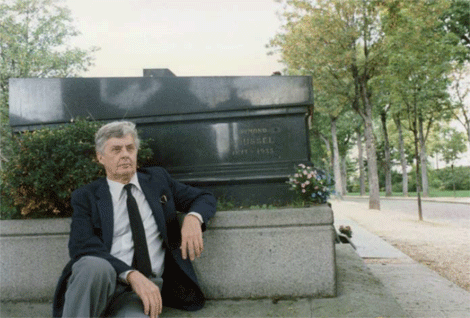 © Remco Campert
| |
[pagina 289]
| |
Raymond RousselYou can't always agree about everything, and one of the writers Rudy and I disagreed about was Raymond Roussel. He had all Roussel's books, in those lovely red Pauvert editions: one unreadable title after another: Locus Solus, Impressions d'Afrique, Comment j'ai écrit certains de mes livres. There was also La Vue, a poem about looking into a tiny lens containing a seaside scene; long ago Rudy's mother had owned such a lens, known as a Stanhope, with a view like the one described by Roussel. We started, passionately, to collect Stanhopes but they turned out to be a bit like La Vue itself: fascinating at first, then quite quickly less so. Roussel is buried at Père Lachaise, in the 89e division, and this photo was taken by Remco Campert; I have the matching one of him taken by Rudy. I also have a number of other photos of Rudy taken by the graves of writers he admired. In retrospect I seem to have spent a lot of time in cemeteries with him, and that is without counting the hours with our daughter in the cimetière de Montmartre, the nearest place for a walk when we lived in the rue Blanche. Stendhal, the novelist Rudy most admired, was there, as well as Zola, Théophile Gautier, Heine, Alfred de Vigny and the frères Goncourt. The best photograph of Rudy beside a grave is the one on the back of Restjes, at Turgenev's grave in St Petersburg. It was taken by the very daughter whose earliest trips in her pram were to a cemetery (I knew someone else who took her infant son there as well, but, as she said, ‘only until he could sit up and see where he was’). But we also have him with, among others, Topor, Beckett, Yeats, Pound, Brodsky, Karen Blixen and Lampedusa. It is not easy to photograph someone beside a grave, especially if it is low on the ground; Remco got Rudy to sit down, so this is a much better picture than most of mine. | |
[pagina 290]
| |
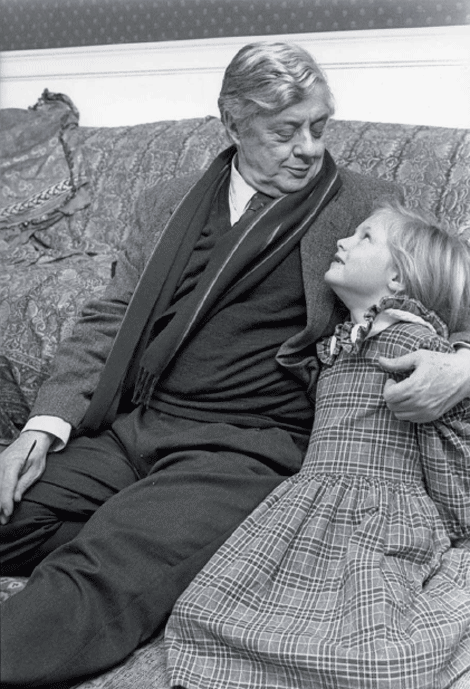 © Steye Raviez
| |
[pagina 291]
| |
HannahRudy didn't like being photographed; in the last ten years or so he simply refused when publishers or newspapers wanted a picture of him. Before that professional photographers would come to the house and do their best with him. This photo, taken by Steye Raviez in about 1992, when Hannah was five, is a by-product of one of those sessions. Rudy wasn't pleased with the portrait taken at the same time and he had put it away, with this one, so I hadn't seen either of them since they were taken. The two of them are sitting on the floor, as Rudy often did; he would slide forward off his chair, sometimes ending up sitting with his legs under him, in a Japanese way that looked very uncomfortable. He did it right up to the end of his life, even doctors remarked upon it. I have a photo of him sitting like that, but an amateur one, badly framed, and that brings me to the most important thing about this photo, which is that it is not the kind of picture that amateurs take. Rudy's parents' photograph albums were lost during the war, along with all their other possessions. But his parents had sent, or brought, photos back to their own parents, and these albums, which document his first ten years, still exist. The photos have lengthy captions, intended for the grandparents, and probably containing much more information than if they had been meant for their own albums: just what posterity wants. But of course they are small pictures, family photos with people facing the camera, posed, and recording events like Koninginnedag, Christmas, a swimming diploma, departure for school. They are inconceivably precious if they are all you have of your youth, but they are nothing like this photo. When I look at this one, all the more striking as it had been forgotten for so long, I remember exactly when it was taken, how the photographer came to the house, what the furniture was like then, the colour of Rudy's jacket and scarf, how proud I was of Hannah in her dress - everything, in short, except for that precise moment, the moment when they looked at each other. | |
[pagina 292]
| |
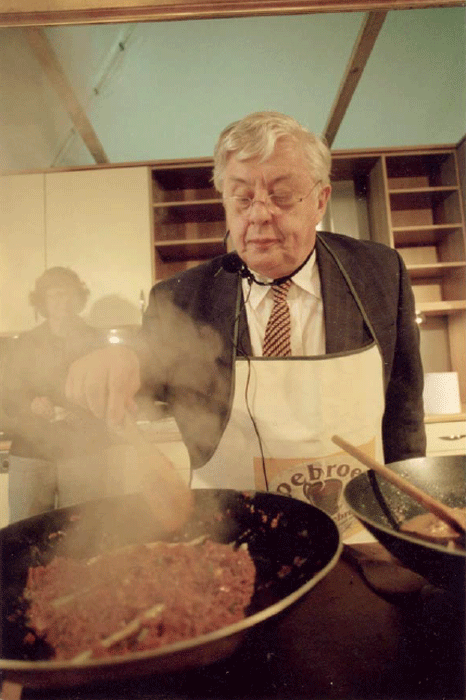 © Serge Ligtenberg
| |
[pagina 293]
| |
CookingThe first time I ate Indonesian food was with Rudy, at a restaurant in Scheveningen. It was a memorable occasion: one of the dishes he chose, something with egg (delicious, he said), was so spicy that I was unable to speak for the rest of the meal. When he was a child, he told me, they used to compete as to who could eat the most fiery red peppers. Rudy could whip up an Indonesian meal in minutes; if people came by unexpectedly he never panicked, just put on the rice and combed the kitchen for other ingredients. His cooking was fast and impatient, completely the opposite to his writing. He didn't like having people in the kitchen while he was cooking; I was only allowed to chop the onions, and that, he said, far too slowly. But he made the most delicious meals, with many different dishes, which all had to be eaten separately - he was very critical of people mixing them together on their plates - and of course with a spoon and fork. In Paris he used to buy ingredients at the Vietnamese shops in the place Maubert; his cooking there was different from here. Thirty-five years ago he showed me how to make nasi goreng, I carefully wrote down the recipe, made it for myself many times, then years later made it for Rudy. It was just like riz cantonnais, he said, the French version of Chinese fried rice; nasi goreng as he used to make it, literally a taste from the past. So it was no use asking him for recipes, the dishes came out different every time. He himself attributed this to having learned to cook in the camp, where you used whatever was at hand. That is what he is demonstrating in this picture, at the Pasar Malam in The Hague. It was supposed to be like a cooking programme on television but, as a friend remarked at the time, Rudy must have been the only person in the world who had never seen such a programme. Nor was his audience of Indische ladies, experts one and all, expecting a kind of Indonesian cooking that used ingredients like corned beef and tinned jackfruit. When another demonstrator tried to interfere Rudy simply batted her away. It was a cooking demonstration unlike any other, unintentionally hilarious, but he still produced a decent meal. And all the Indische ladies lined up at the end to taste it. | |
[pagina 294]
| |
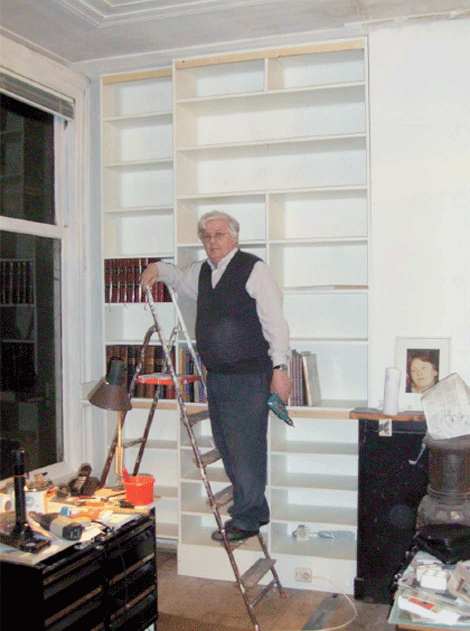 © Sarah Hart
| |
[pagina 295]
| |
BookcasesPeople are surprised to hear of an intellectual building his own bookcases; Rudy built a whole house. It was an attic in Boulogne, near Paris, which he transformed, lifting the roof, putting in windows, making a kitchen and bathroom, installing electricity and central heating: a real house, which he lived in for years. I have only been there twice, the second time was after new people had bought it and had a beam removed that ran diagonally from ceiling to floor through the middle of the sitting room. Rudy shuddered when he saw it was gone, knowing exactly what it used to hold up. In this picture he is finishing the bookcase behind his desk in the house in Leiden. The first books to have been put into it are the Larousse du xixe siècle, bottom left, and the Oeuvres romanesques of Marcel Aymé with illustrations by Topor, above them. The shelves were designed to fit those books, and they still stand there now. On the right is a stove that was used in the house in Boulogne; it is called By Far the Best, and Cézanne had exactly the same one in his studio. Rudy built many bookshelves, bookcases and cupboards in other houses. He made our bed in the rue Blanche, the desk I am writing at now. He built fireplaces, added moulding to ceilings, turned narrow planks into wide ones by filling in the gaps between them. He put twenty layers of varnish onto a picture frame, smoothing each one with fine sandpaper and water. He made a replica of the decorated end of a brass curtain rail out of plaster, then painted it so well that I can no longer tell which one it was. All this was done meticulously - sometimes so meticulously that it was never quite finished - and with the right materials. In Paris these materials came from the basement of the Bazar de l'Hôtel de Ville, his favourite shop; they had everything you needed to build a house, some of it, not now but in those days, still suitable for a 19th century house. He knew the names of tools and parts of houses better in French than in Dutch, and French products were indispensable too: Popote Fabourg, Dégryp-Oil, Zébraline. He complained, in Holland, about the poor assortment in the shops, and whenever we were in Paris we had to go to the bhv. Here he is holding a drill that Hepzibah gave him when we came to | |
[pagina 296]
| |
Leiden, an excellent tool, which served him well for years. It is broken now and the one we bought to replace it is nowhere near as good. Hepzibah grew up in that house in Boulogne and she went back to look at it a few months before she died: it has gone, not just the attic but the whole building. |
|

